Abstract
Nowadays Russian industrial enterprises operate amid global competition at the world market. That is why the policy concerning industrial enterprises is focused on arrangement of conditions and implementation of a set of measures aimed to encourage those progressive structural changes in production that can meet the world's requirements. In the authors’ opinion, the desired objective can be achieved by innovation activity encouragement at enterprises. The purpose of the present article is development and elaboration of efficiency of the innovation activity mechanism of industrial enterprises. The target of the research is innovation and investment processes of industrial enterprises. The methodological foundation of the scientific article is the complex approach to study of organizational and economic phenomena in the sphere of innovation activity of industrial enterprises. The academic novelty lies in theoretical justification and elaboration of methodological approaches to encouragement of innovation activity of industrial enterprises at the present development stage. The authors designed the mechanism to encourage innovation activity of industrial enterprises that contributes to activization and growth of innovations. Forms of enterprises interaction that promote the efficiency of management structures of innovation activity are revealed. The article offers an economic matrix developed to assess practicality and efficiency of public forms interaction based on positive and negative factors. Thus, the article provides and proves the efficiency of the designed mechanism to encourage innovation activity of industrial enterprises, which is able to increase innovation potential of the economy and to take innovatively active enterprises to the world standard level.
Keywords: Innovation activityinvestmentsindustrial enterprisescompetitivenessenterprises interactionpotential of the enterprise
Introduction
At present, one of the key and topical issues in Russia is development of ways and mechanisms of real sector, its recovery as the basis of economic growth.
Schumpeter (1982) marked innovations and entrepreneurial resource creating a market for innovations and their excessive supply as the key factor of innovation economic development.
Industrial innovation activity is explained by the economic regularities, which are peculiar to the market economy of innovation type. Introduction of innovations (a group of actions aimed to create and obtain, master and distribute new and improved kinds of products, technologies, raw and other materials, management methods, etc.) into industrial enterprises promotes profit maximization, healthy market competition, and also is an important component of sustained growth of the national economy.
The growth rate of the economic development of the state and its certain regions (Epstein, Davila, & Matusik, 2004) is defined by, first of all, a degree of maturity of science, education, knowledge-intensive industries, an approach to international technology markets. International industrial development trends analysis (Galende & De la Fuente, 2003; Hansen & Winter, 2011) shows that the 21st century will demand the following key priorities in study and acquisition:
creation of newest forecast and industrial potential assessment technologies which allow significant reduction of time span and its costly characteristic;
transition from ecologically and socially dangerous methods of open and deep mining to geotechnological ones (hydraulic borehole mining, underground leaching, underground coal gasification, underground sulfur fusion, etc.);
development of highly efficient technologies of соmprehensive raw mineral processing, design of complex waste-free closed power enrichment systems and eventual outcome generation; development of radically new technologies of mineral processing – primarily with the use of bioorganisms, plasma chemical reaction, etc.;
development of new deep fields of mineral deposits at the bottom of the global ocean; involvement of non-conventional kinds of fuel-power resources (solar, wind, tide flow energy etc.) in industry.
Investment and innovation activity is directed to implementation of industrial development prospects and is directly relevant to strategic planning, as it is intended to ensure agreeing of long-term objectives of the economic operator and to increase resource utilization efficiency.
Problem Statement
Scientific basis for efficiency of the mechanism of industrial innovation activity encouragement.
Robust relationship between investments and innovations raises certain difficulties when isolated (Frenkel, 2003; Nelson & Nelson, 2002). It means that each component has to have a definite economic activity sphere, responsible for financing and management of renewal processes of all elements of the economic operator in market economy. The company aimed at successful performance at the market has to be ready to explore and implement innovations continuously.
However, innovation activity cannot be regarded only as an isolated economic activity area.
Applicability of effective innovative potential of the enterprise depends directly on factual interrelations between innovation systems success and ease of investment environment in the regions.
Figure
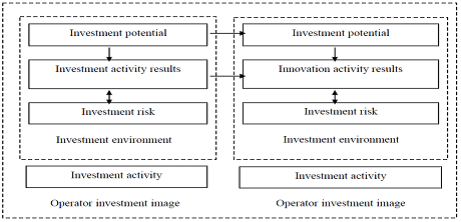
At the very elementary stage of consideration of innovation mechanism, it is necessary to pay attention to the analysis of interrelation between innovation potential of the enterprise and innovation activity results. Innovation potential of industrial enterprises (Andergassen, Nardini, & Ricottilli 2009) is considered in this case as innovation resources transformation (Arvanitis, 2000; Stuart, 2000) through innovation technologies and innovation activity encouragement methods, which are mainly developed and realized regionally with due regard to economic, geographical, ecological and other conditions (Hadhri, Arvanitis & M'henni, 2016).
An innovation process is the basic element of an innovation activity mechanism with a cyclical character, which reflects a chronological order of innovations appearance. Its ultimate outcome is innovations commercial feasibility, which has the following indispensable attributes: scientific and technical originality and industrial workability (Autant-Bernard, Fadairo, & Massard, 2013; Veselovsky, Khoroshavina, Bank, Suglobov, & Khmelev, 2017).
Implementation of new technologies in production and management of the enterprise, innovation production output increase the competitiveness of business units and raise their investment attractiveness.
Research Questions
Resulting from complexity and variety of the factors influencing the innovation process, there is objective necessity to consider its basic elements step-by-step and in detail. Herewith, the main target is determination of the most influential factors, with the help of which it will be possible to encourage innovation activity of industrial enterprises (Fig.02).
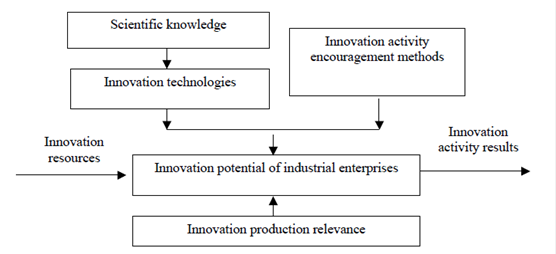
Purpose of the Study
The scheme shows transformation of scientific knowledge (ideas, discoveries, inventions), innovation technologies into new or improved products implemented in production as the result of formation of a development model, transformation and application of social, natural and economic resources.
It is undisputed that the basic source of something “new” is knowledge. It allows generating the acceptable level of novelties, which are in the form of products, goods and services become innovations. Of all resources needed for implementation of innovation in the company, it is human capital asset that acts as the main creative power, and that is why it needs use to the maximum extent possible.
The authors designed the industrial mechanism of innovation activity encouragement (Fig. 03)
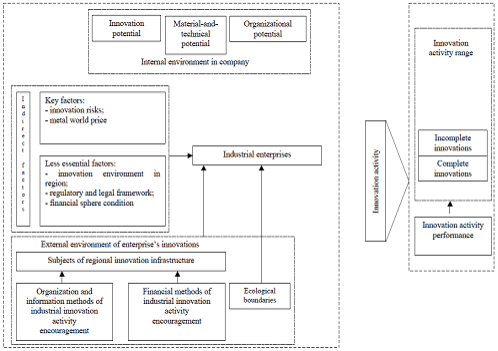
Innovations encouragement is a process of creation of advantages to satisfy economic and social needs of the enterprises developing and implementing innovations.
Nowadays industrial enterprises enjoy rather high potential of innovation activity; however, various factors thwart progress of innovation industry.
Figure
Financial methods of encouragement of industrial innovation activity must include: easy-term loan development for innovation projects (accumulation of funds from various sources, interest rate alleviation and paydown, etc.); leasing, franchising activities promotion; innovation risks insurance and reinsurance.
Organizational methods of encouragement of industrial innovation activity must include: state certification of innovation projects with a simultaneous issue of part loss guarantee in the case of unsuccessful project realization; expansion and modernization of the personnel training and retraining system for innovation economy according to sector-specific issues; engineering support of innovations (both new technologies and new equipment including financially leased).
Information methods of encouragement of industrial innovation activity must include: ongoing monitoring of the scientific and innovation sphere (both domestic and overseas); issue of novelties directory and its spread among all participants of scientific and industrial interaction to build constructive communication between science and production; marketing research aimed to study demand for innovations, industry included; intensive employment of propaganda and PR methods to create favorable investment and innovation image of the region and industry, and also to advertise advantages of new technologies in industry.
According to scientists, only 2% of raw materials, which are mined, turn into useful products, and 98% of them return to nature in the form of various wastes. Implementation of ecological standards is an internationally recognized method of enterprises’ innovation activity encouragement (Becker & Dietz , 2004; Coad & Rao, 2008), as it forces them to introduce the improved and ecologically-friendly technologies in raw materials mining and processing in order to reduce payment for environment pollution (Freel, 2006; Stieglitz & Heine, 2007), and, consequently, to achieve ecological and social effect.
Research Methods
Methodological approaches to evaluation of innovation policy performance
The structure of innovation activity management must be targeted to provide competitiveness of industrial enterprises and production (Storey & Tether, 1998), to provide productiveness (Guan & Yam, 2015; Segarra &. Arauzo, 2010), ecological and social environment improvement (Loukil, 2016). General economic efficiency must be provided for the involved and adjoining enterprises, particularly for innovation activity enterprises. But the most important thing is that end-to-end performance (including economic, social and regional efficiency) must be focused on the regional management system as a whole and a person. In innovation activity, the management structure must be adjustable, able to fast transformations according to changes on international market and inside the company. Such changes can be resulted from venture companies creation or mass switch to prospective scientific and technical production.
Structure efficiency of innovation activity management is not defined mainly by forms of innovation enterprises, but by forms of interaction between enterprises and companies: scientific, industrial and infrastructure. The interaction forms of enterprises related to each group of alliance are displayed in Figure
The current context sees more and more new forms and ways of interrelations between companies.
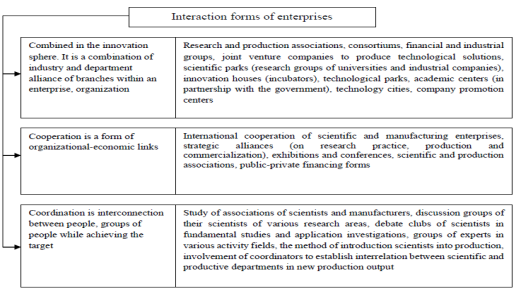
Combination is one of the most compound forms of organization. It combines cooperation and coordination forms. Cooperation can include a coordination form. The enterprises’ integration target when combining is development of a single production line in scientific and technical projects, processing of raw materials, production of components, transportation and assembly of goods
Cooperation is performed on the basis of industrial, scientific and technical, and commercial collaboration agreement.
Coordination at innovation enterprises is in demand due to complicated and contradictory relations between industrial, scientific and marketing services. Coordination improvement is achieved by virtue of services operation regulations and duty instructions, tightening of operational discipline, etc.
For feasibility study of public organizational form, its impact on the enterprise’s efficiency, development leveling of the form, the expert method with Boolean variables is offered.
To process the data, it is offered to use a matrix where intensity of the factors relevant to the forms is defined. The first five factors are positive; three factors are negative. There are questions:
1) How intensive are the factors for the created project enterprise?
2) How developed are the organizational forms in the functioning enterprise?
They assess the degree of conformity of j-form to the projected condition on each i-factor and in the matrix they set the variables: r=1 (the high intensity), for other conditions r=0.5 or r=0.
Experts evaluate the rank (weight) characteristics of the factors - .
Herewith, the sum of positive ranks:
(1)
The sum of negative factors:
(2)
The importance factors indexes are estimated for organizational j-form:
(3)
The criterion of selection or organizational form assessment is .
The criterion of form development assessment:
(4)
where — ranks of negative factors;
— ranks of positive factors.
The results of assessment and selection of the forms go to the matrix (Table
The offered matrix of conformity, organizational public forms efficiency assessment allows proving the interrelations between the most powerful factors (positive/negative) affecting innovation activity of industrial enterprises as well as strategic orientation of innovation activity.
Development cannot result from two or three export or intransit projects with no integrated approach to investment in innovation activity in its entirety. It will only lead to local effects which will still perform intransit and primary functions solely. Proceeding from this condition, it is necessary to assess in general how efficient will be the complex of measures to encourage industrial investment and innovation activity (if only for one particular industry).
Methodical approaches
In order to choose a method (methods) to define efficiency assessment of investment in innovation activity of the regional enterprises, the authors advise a methodological sequence of the methods shown in Figure
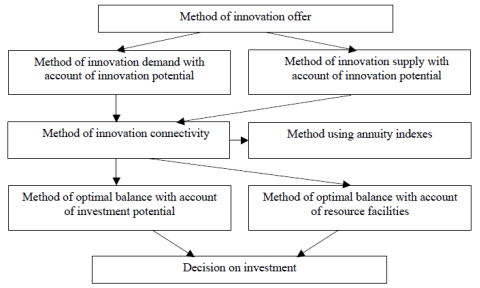
It is a stark fact that in order to choose prioritized innovation directions and projects within the framework of investment and innovation policy, it is necessary to evaluate the efficiency of their implementations in advance.
Findings
There are a number of approaches and techniques to evaluate innovation and investment activity (Fagerberg, 2005). In the authors’ opinion, the innovation activity efficiency (in some certain industry) must be evaluated through two sequential methods: 1. as a ranking score of practicability and effectiveness of innovation activity forms; 2. as a resulting impact of the total amount of investment in innovation activity on the regional economy. Recommendations on improvement of the finance system of the innovation sector of enterprises.
Conclusion
As part of the research, the interconnection between the key innovation and investment figure blocks was studied, and also the basic elements of industrial innovation activity encouragement mechanism were revealed. Besides that, a methodological approach to preliminary estimates of investment and innovation activity in industry was offered. Nonetheless, it is important to remember that in order to achieve economic, social and other results from investment processes, a favorable investment and innovation environment must be created to attract domestic and international investors.
Hence, a plan of organizational-economic actions on four basic directions is suggested: 1. investment processes development; 2. innovation activity promotion; 3. finance and credit sphere advancement; 4. territorial policy implementation. Development of growth points.
Thus, implementation of industrial investment and a mechanism of innovation activity encouragement will induce transformations to provide high quality innovations, profit maximization, world market competitiveness, etc.
References
- Andergassen, R., Nardini, F., & Ricottilli, M. (2009). Innovation and growth through local and global interaction. Journal of Economic Dynamics & Control, 33, 1779-1795. Doi: http://dx.doi.org/10.1016/j.jedc.2009.04.003.
- Arvanitis, R., Villavicencio, D. (2000). "Learning and innovation in the chemical industry in Mexico ". In Developing innovation systems: Mexico in a Global Context, M. Cimoli (Ed). London, Pinter. 189-205.
- Autant-Bernard, C., Fadairo, M., & Massard, N. (2013). Knowledge diffusion and innovation policies within the European regions: Challenges based on recent empirical evidence. Research Policy, 1, 196–210.
- Becker, W., & Dietz, J. (2004). R&D cooperation and innovation activities of firms-evidence for the German industry. Research Policy, 33, 209-223.
- Coad, A., Rao, R. (2008). Innovation and firm growth in high-tech sectors: A quantile regression approach. Research policy 37, 633-648.
- Epstein, M.J., Davila, T. & Matusik, S. (2004). Innovation strategy and the use of performance measures. Advances in Management Accounting, 13, 27-58. Doi: http://dx.doi.org/10.1016/S1474-7871(04)13002-5.
- Fagerberg, J. (2005). The Oxford handbook of innovation. Oxford university press.
- Freel, M. (2006). Patterns of technological innovation in knowledge-intensive business services. Industry & Innovation, 13, 3, 335-58.
- Frenkel, A. (2003). Barriers and Limitations in the Development of Industrial Innovation in the Region. European Planning Studies, 11, 115-137.
- Galende, J., & De la Fuente, J.M. (2003). Internal factors determining a firm’s innovative behaviour. Research Policy, 32 (5), 715-736.
- Guan, J.C., & Yam R.C.M. (2015). Effects of government financial incentives on firms’ innovation performance in China: Evidences from Beijing in the 1990s. Research Policy, 44, 273-282.
- Hadhri, W., Arvanitis, R., & M'henni, H. (2016). Determinants of Innovation Activities in Small and Open Economies: The Lebanese Business Sector. Journal of Innovation Economics & Management, 3 (21), 77-107.
- Hansen, T., & Winter, L. (2011). Innovation, regional development and relations between high-and low-tech industries. European Urban and Regional Studies, 18, 3, 321-339.
- Loukil, K. (2016). Foreign direct investment and technological innovation in developing countries. Oradea Journal of Business and Economics, 1 (2), 31-40.
- Veselovsky, M.Y., Khoroshavina, N.S., Bank, O.A., Suglobov, A.E., & Khmelev, S.A. (2017). Characteristics of the Innovation Development of Russia’s Industrial Enterprises under Conditions of Economic Sanctions, Journal of Applied Economic Sciences. Volume XII Issue 2 (48). 321-331.
- Nelson, R.R., & Nelson, K. (2002). Technology, institutions, and innovation systems. Research Policy, 31, 2, 265-72.
- Schumpeter, J (1982). The theory of economic development. Moscow: Progress, 456 p.
- Segarra, A., & Arauzo, J.M. (2010). Innovation and productivity in manufacturing and service firms in Catalonia: a regional approach. Economics of Innovation and New Technology, 19, 3, 233-258.
- Stieglitz, N., & Heine, K. (2007). Innovations and the role of complementarities in a strategic theory of the firm. Strategic Management Journal, 28, 1, 1-15.
- Storey, D.J., & Tether, B.S. (1998). Public policy measures to support new technology-based firms in the European Union. Research policy 9, 1037-1057.
- Stuart, T.E. (2000). Interorganizational alliances and the performance of firms: A study of growth and innovation rates in a high-technology industry. Strategic management journal, 21, 791-811.
Copyright information

This work is licensed under a Creative Commons Attribution-NonCommercial-NoDerivatives 4.0 International License.
About this article
Publication Date
17 December 2018
Article Doi
eBook ISBN
978-1-80296-049-5
Publisher
Future Academy
Volume
50
Print ISBN (optional)
-
Edition Number
1st Edition
Pages
1-1464
Subjects
Social sciences, modern society,innovation, social science and technology, organizational behaviour, organizational theory
Cite this article as:
Nikityuk, L. G., Grigorova, L. E., Timchuc, O. G., & Ogloblin, V. A. (2018). Encouragement Of Innovation Activity Of Industrial Enterprises. In I. B. Ardashkin, B. Vladimir Iosifovich, & N. V. Martyushev (Eds.), Research Paradigms Transformation in Social Sciences, vol 50. European Proceedings of Social and Behavioural Sciences (pp. 900-910). Future Academy. https://doi.org/10.15405/epsbs.2018.12.110

